The human brain is a pattern-recognition machine. We seem to be hardwired to search for and gather objects that share certain characteristics, regardless of those items’ intrinsic value or ultimate utility. Next we sort, categorize and display our objects in creative and unusual ways, often to the befuddlement, consternation or even inconvenience of family and friends, who can think of far better uses of one’s spare time and basement space.
What is it that fuels the collector’s passion? Curiosity, certainly. Perhaps aesthetic attraction. For some, it’s a desire to connect with a past era they never knew. For others, it could be a Sisyphean compulsion to complete an incomplete “set.” And, of course, some might be hiding a hoarding disorder behind those über-organizational skills.
This week, Seven Days takes a look at seven passionate Vermonters and their unusual collections. In some cases, such as Glenn Eames’ vintage bicycles and Sidney Stetson’s mah jongg sets, an obsession shared with other collectors around the globe lends the objects monetary value. When it comes to Josh Slocum’s shrunken heads and Ralph Farnsworth’s paper cups from old fast-food joints, maybe not so much.
This group of gifted gleaners illustrates the very human tendency to draw satisfaction from hunting and gathering, even if the prey is a Mickey Mouse mug.
KEN PICARD
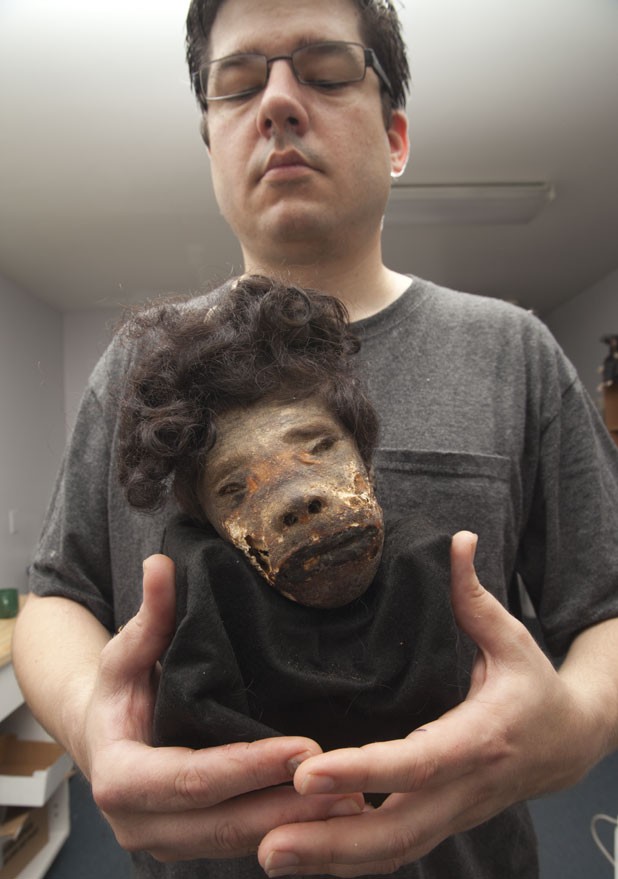
Final Effects
Good grief! Each week, Josh Slocum fields hundreds of calls and emails from mourning, distraught or pissed-off family members. Sometimes their loved ones’ bodies or cremated remains have gone missing. Other times, they’ve had a burial plot resold or a headstone moved without their knowledge. On rarer occasions, someone reports a maggot-filled casket or an exploding mausoleum vault. Most days, however, Slocum’s callers are simply the hapless victims of unscrupulous morticians.
For more than a decade, Slocum has been executive director of the Funeral Consumers Alliance, the nation’s leading consumer watchdog group for America’s death industry. In that role, he’s accumulated not only some hair-raising stories but also a fascinating collection of curios, some of which decorate his otherwise spartan office in South Burlington.
Atop a bookshelf crammed with the requisite death-related titles — The High Cost of Dying, Grave Matters, A Plain Pine Box and Making an Exit — sits a six-pack of Dead Guy Ale, a bottle of Bluelips Embalmer’s Hot Sauce and a Grim Reaper hand puppet. (Alas, on the day I visited, Slocum’s antique embalming-fluid jar was at home.)
Far more interesting are the funeral-business items in his collection, which seem benign until Slocum explains their true purpose. There’s a white plastic screw that resembles something used to hang pictures in drywall. In fact, it’s a cap for sealing the incision hole made in an abdominal cavity when a funeral director embalms a body.
Next, Slocum displays a larger plastic screw, used to prevent leakage of bodily fluids from the corpse.
“Here’s the fabulously named ‘AV closure,’ a multipurpose, multiorifice plug,” Slocum says with equal parts playfulness and contempt. “I think they advertise it as providing the deceased with ‘dignity.’ How dignified is it having a butt plug shoved inside you when you’re in the casket?”
Other items in the collection include a spiked mouth cap, used for preventing the dearly departed from inadvertently smiling during his or her eulogy. A similar but smaller cap, about the size of a contact lens, is used for keeping the deceased’s eyelids shut. “Grisly, isn’t it?” Slocum notes.
“Oh, this is cool! You won’t see this anymore,” he adds, producing a small plastic container from the Heller-Hoenstine Funeral Home in Lewistown, Pa. Inside are smelling salts, presumably for use in the event someone faints from grief during a funeral.
“This used to be standard fare at all funeral homes,” Slocum explains. “Of course, nearly all of that fainting was for dramatic purpose.”
The most fascinating items in Slocum’s collection are two genuine Jivaro shrunken heads from South America. About five years ago, an elderly German woman in Arizona called to ask Slocum if he wanted them. While cleaning out her house before a move, she’d discovered the heads among her dead husband’s belongings.
Evidently, the caller’s husband had been an employee of Standard Oil and spent years prospecting in South America, where he amassed a large anthropological collection. According to Slocum, the woman tried donating the heads to universities and museums, which all rejected them because she couldn’t verify their provenance.
“They’re an interesting curiosity, but if they’re to be kept extant, they should be better taken care [of] than what we can do,” Slocum says. How old are the heads? “Not a clue.”
Slocum admits his collection is of less than museum quality. Nevertheless, he says that if he were approached by an institution that could properly display and curate the shrunken heads, he’d happily part with them. As he notes, “We never even got around to naming them.”
Words by Ken Picard, photos by Matthew Thorsen.
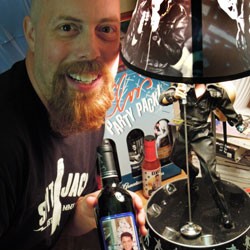
Kingly Pursuits
Tom Theohary discovered Elvis Presley on a 45 in his grandmother’s attic when he was about 8 years old. The song was “Hound Dog,” the sound “bad-ass rock and roll,” he says. And Theohary fell in love … with the King.
One of his first album purchases was Elvis Live, he recalls, but it wasn’t until years later that Theohary, now 45, began to collect Elvis tchotchkes. Back home in Lowell, Mass., he had an Elvis “shrine” in his bathroom. “You know that’s where he died,” Theohary explains with tongue-in-cheek reverence.
After he bought a home off the Sugarbush Access Road in Warren six or so years ago, Theohary’s guest room — he calls it the “honeymoon suite” — became the repository of all things Elvis. And the collection grew. In fact, he explains to marveling visitors, waving his arm around the packed room, “Other people have given me most of this stuff.”
The “stuff” includes some historic mementos but is mostly kitsch: a lamp featuring Elvis in black leather who swivels those famous hips when Theohary turns it on. Lots of dolls, cards and pens. A flipbook. A clock that plays a snippet of an Elvis tune on the hour, every hour. (“I had to turn that off,” Theohary admits. “You don’t want to hear that at three in the morning.”) Videos of Presley movies. Elvis on plastic shower curtains, a lunch box, Pez dispensers. Elvis at successive ages in a set of nesting dolls. Ties, scarves, hot sauce bottles. There’s even an Elvis wine. Perhaps the weirdest item is a bust of Elvis carved from a stack of gray cardboard slices. “I call it ‘topographical Elvis,’” Theohary says.
Clad in a black T-shirt bearing the name of his own current band, Spit Jack, Theohary introduces each item with an anecdote about its provenance. That “Poco Elvis” — a wriggling figure intended for a car dashboard — was purchased in Spain from a street vendor. A friend made the blue velvet drapes with way-larger-than-life portraits of the King. She also made the “bad-ass” white jumpsuit that Theohary pulls from the closet. “I’m trying to bring the cape back into fashion,” he quips.
Showing a photograph of himself wearing said jumpsuit — and a black wig of Elvis hair — the bearded Theohary launches into a tale about going to an impersonators’ convention in Virginia and finding himself expected to act, well, King-like.
Theohary’s boundless enthusiasm fails to disturb his cat, Lisa Marie, who is curled up on a small couch. She doesn’t even look up when he points to the 1969 cover of Rolling Stone featuring Elvis that hangs over the bed. Or to the colorful poster — matted in blue suede and framed in gold — from the 1964 movie Viva Las Vegas. Theohary observes of Presley’s costar, the redheaded and comely Ann-Margret, “She was smokin’!”
Which brings up the inevitable question: young, hot Elvis or old, fat Elvis (whom so many impersonators seem to prefer)?
“Musically, young Elvis, definitely, but I like the showmanship of the older Elvis,” Theohary equivocates, before chiding the questioner: “Vegas Elvis, please — show some respect!”
Asked if there are any Elvis items he would still like to collect, Theohary says without hesitation, “a gold belt or one of his bad-ass rings.” Holding up a tiny, gold-plated TCB pin (for Taking Care of Business, which is what Presley called his band), he adds, “Elvis had some cool bling. He was the first with bling, the entourage, the gold chains.” Take that, hip-hop copycats.
Words by Pamela Polston, photos by Barbara Leslie.

Chief Mouseketeer
How does Steve McQueen, Winooski’s police chief of 17 years, spend his free time? Considering that he has the same name as the macho Hollywood actor once dubbed the “king of cool,” one might guess Winooski’s McQueen would collect race cars, vintage motorcycles or World War II firearms.
Try Tinker Bell pins and Mickey Mouse coffee mugs.
Yes, Winooski’s top cop is an unabashed Disney fanatic. How much of a fan? McQueen wears a Mickey Mouse watch to work every day. His cellphone ringtone is the original “Mickey Mouse Club” theme song. Even his police cruiser sports a Mickey Mouse antenna topper. “Always has,” he says. “Why not?”
McQueen, 53, first visited Disney World in 1974. He hasn’t missed a year since 1982, and he and his wife, Josie — whose license plate reads “VTNKRBL” — honeymooned there 20 years ago. They’ve been known to go three or four times a year.
A major part of every trip is collecting and trading new and vintage Disney memorabilia, McQueen explains.
“I probably have every park map and schedule for every trip we’ve ever taken to Disneyworld since 1974,” he says. That would be more than 50 trips.
In fact, the McQueens’ Essex house includes a spare bedroom where they display more than 800 Disney pins they’ve purchased or traded at Disneyworld or on Disney cruises. During these excursions, the couple wear lanyards with pins to trade with children, fellow collectors or Disney staffers, whom McQueen calls “cast members.” Some of their pins go for $800 or more.
“Yeah, we’ve got that stuff all over the place,” he says. “We’ve done five of the Disney cruises, which are absolutely amazing. You cannot find better entertainment. But you’d better like Disney.”
McQueen doesn’t confine his hobby to his home. Displayed in his office are various Disney doodads, including a miniature Mickey Mouse phone, a toy race car from the 2006 animated Pixar film Cars — “Lightning McQueen, of course,” he notes — and a 1978 collection of record albums celebrating 50 years of Disney motion-picture music. It’s still sealed in the original plastic.
Hanging behind McQueen’s desk is a black-and-white photo of Walt Disney with the quote, “It’s kind of fun to do the impossible.”
“I’ve always felt a connection to that kind of thinking,” McQueen explains. “And it’s pure escapism.”
This Sunday, August 19, the McQueens will be attending their daughter’s wedding in England. Afterward, they’ll use their Disney timeshare to stay at Disneyland Paris, where they’ll undoubtedly collect more schwag.
In a profession whose practitioners typically pride themselves on a tough-guy demeanor, is McQueen at all concerned that his proclivity for pixies and princesses will make him look, well, a bit goofy? Not at all, McQueen says.
“I go to every chiefs’ meeting with my Disney cup,” he says. “To me, having this with me at meetings is a reminder that we cannot take ourselves too seriously.”
Words by Ken Picard, photos by Matthew Thorsen.
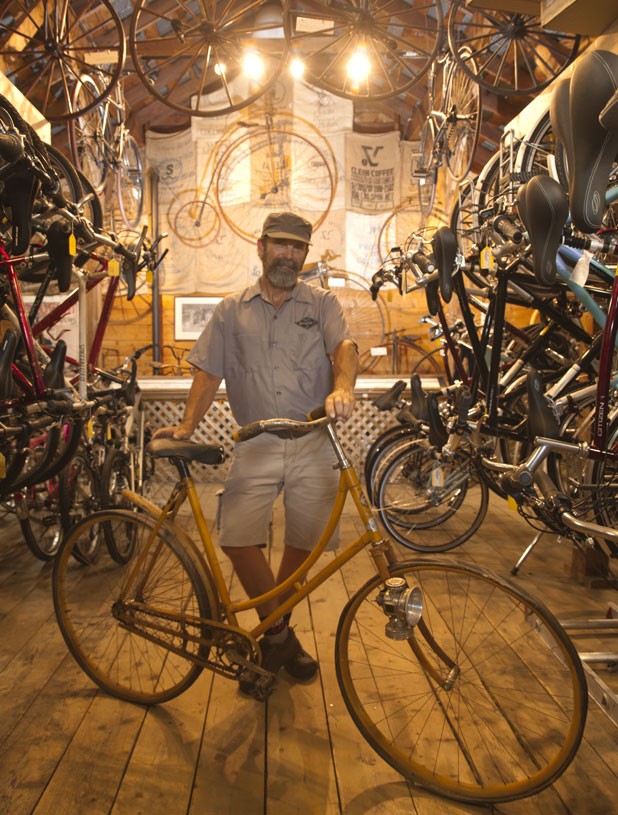
Wheels of Life
Before discussing his extensive collection of bicycles that are at least a century old, Glenn Eames wants to make clear that he’s hostile to the notion of collecting anything.
“It’s a bizarre, materialist illness,” he says unsmilingly. “A lot of collectors are obsessive, compulsive materialists who have to have it all. They’re hoarding objects — that’s the dark side of collecting.”
Eames doesn’t exempt himself from this blanket denunciation — he says he’s bothered by the “collecting thing” when he looks in the mirror in the morning — but he does offer an apologia of sorts. “What fascinated me about old bikes was not the gathering of objects themselves,” Eames says while seated on a bench outside the Old Spokes Home, the cycling shop he owns on North Winooski Avenue in Burlington. “It was the developing of an understanding of how they transformed American society in the late 19th century.”
For him, he adds, collecting offers “a pathway to understanding the past.”
Eames, 60, says he’s always been interested in history — and in collecting. He started in a suburb of Boston with a typical boyhood accumulation of rocks and minerals. As a baby boomer with parents who told stories about World War II, the adolescent Glenn collected military memorabilia. “While other kids were out playing softball, I’d be up in attics looking for souvenirs of war,” he recalls.
“I wanted to be an archaeologist, a paleontologist, a geologist,” Eames says. Instead, he joined the Navy.
That was a way of staying ahead of the draft, which could have funneled him to Vietnam, Eames explains. Following his discharge in 1973, “I felt a need to change my lifestyle,” he continues. “I was a smoker and just a drifting young man.”
And so he got into biking. Big time.
In 1982, Eames and his partner, Mary Manghis, began a two-year, round-the-world cycling tour. By then, he’d become curious about the history of biking and had acquired his first old-timey specimens. “Living in New England was a stimulus, because this is where the first bicycling boom took place following the Civil War,” he says, “and this was the center of cycle manufacturing, too.”
Today, Eames owns about 60 vintage bikes, many of which are mounted on the walls or hung from the ceiling on the ground floor of the Old Spokes Home. Check out the penny-farthings, for example, with their enormous front wheels and tiny rear wheels. And be sure to ask for access to the second floor — that’s where Eames maintains a curated display of beautiful old bikes. It’s easy to see why he refers to some cycles’ shapes as “sculptural.”
One of his favorites is the circa-1895 Yellow Fellow, so named for a color that stood out among that era’s uniformly black bikes. Eames bought it recently from the grandson of its owner — a woman who owned a saloon and bordello in Aberdeen, Wash., a place once notorious as “the hellhole of the Pacific” and better known today as the hometown of late Nirvana singer Kurt Cobain.
Eames is actually cutting back on his collecting, he says, as he ponders the next decade. He’s become more aware of the transience of life and its accoutrements. Gesturing toward the historic cycles upstairs and the timeline he’s designed for their display, Eames ruminates, “All this stuff… I’m really just its custodian, you know.”
Words by Kevin J. Kelley, photos by Matthew Thorsen.
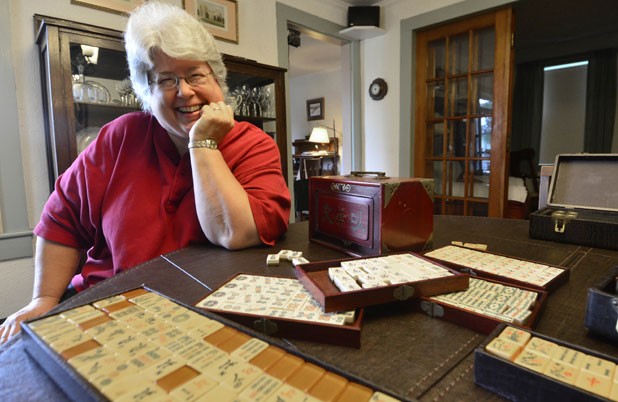
Tile Marker
The root-beer-colored racks elicit wows when Sidney Stetson hauls out her mah- jongg sets for admiring visitors to see. They swoon over the “flowers” that are really tiny figures engaged in different occupations. That exquisitely designed 1 “bam”? OMG. And look at that unusual white dragon! Clearly, the visitors are players, too.
Mah jongg is a classic Chinese game that some aficionados like to think of as “ancient,” but evidence suggests it was developed in the late 1800s. Though mah jongg evolved from much older card games, it employs small tiles that three or four players arrange according to a number of byzantine rules. Complicated and often maddening, the game is utterly addictive. And the tiles, designed with Chinese characters, numbers and pictograms, are beautiful.
Stetson seems to know just about everything about mah jongg. She has several dozen sets. The 65-year-old Northfield retiree acquired her first game in San Francisco in the 1970s. “But I didn’t really become a collector until we decided we only needed one, and decided to sell on eBay,” Stetson explains.
By “we,” she means her and her wife, Janet Townsend, 70, who plays mah jongg but insists she’s not a collector. And by “sell,” Stetson really means buy and sell. And by “one,” she means “about eight or 10 sets we couldn’t part with.” Each of them sees active play.
The sets Stetson shows off all have one thing in common: no jokers. These days, typical mah jongg players (including myself) use sets that include eight jokers among their 152 tiles, and it’s hard to imagine playing without them. But Stetson still plays what she calls an “Asian” version of the game — the first sets imported from China, she explains, allowed for simpler gameplay than we know now. She isn’t sure when, or why, jokers began to appear.
Why have more than one set? Different manufacturers created slight variations on the pieces to distinguish themselves (even Macy’s and Gimbels department stores had their own mah jongg sets at one time), and the fun lies in searching for new ones.
Or, rather, antique ones. Americans went “bonkers” for mah jongg in the 1920s, Stetson says, and several game companies obliged players with gorgeous sets. The earliest ones came in “dressers”-like wooden boxes with little drawers that held the tiles and other accoutrements of the game. In the ’30s and ’40s, various plastics were developed, and they can be seen in the tiles Stetson shows off: Bakelite (familiar to collectors of vintage jewelry) and its successor, the sturdier Catalin.
“Everything started with bone-bamboo sets out of China,” says Stetson, “and grew from that.” Probably only rich people ever had ivory tiles, she notes.
Speaking of money, what do these vintage sets go for? Stetson says she has sold higher-quality sets for $250 to $400 each. A “really special” set she owns, its tiles “enrobed” in a honey-colored plastic, is worth upward of $1500.
But for Stetson, it’s not just about the monetary value. “You collect old things because of their beauty and workmanship,” she says. “Some of these sets are 90 years old.”
Words by Pamela Polston, photos by Jeb Wallace-Brodeur.
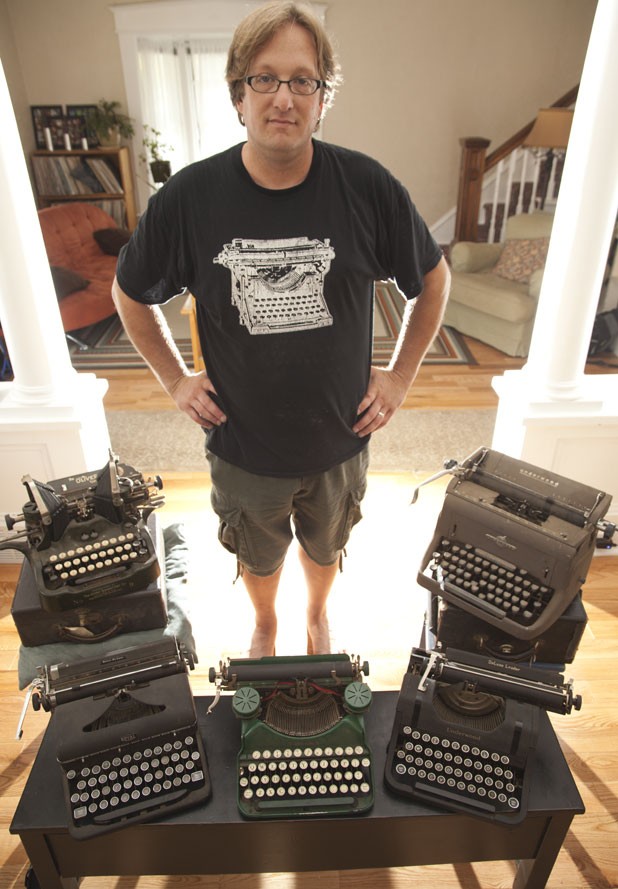
Manual Dexterity
Anyone who has spent time with Shay Totten has spotted the large SHIFT KEY tattoo on his left forearm. It’s apropos body art for someone who has spent much of his life slinging ink — until last December, Totten was the award-winning political columnist for Seven Days. His journalism career has also included stints at the Barton Chronicle, the Burlington Free Press, Vermont Public Television, Vermont Times and the Vermont Guardian.
So why the shift key? For one thing, Totten explains, that’s how you access most of the symbols on a manual typewriter. Second, his favorite typewriter, an Underwood 5, simply wouldn’t fit on his arm — though Twitter enthusiasts will probably recognize that particular model as Totten’s online avatar. (Incidentally, his family’s dog’s name, “Olive,” is short for Olivetti, another typewriter brand.)
Turns out, Vermont’s two-time “social-media king” is also an avid collector of decidedly low-tech writing implements. In fact, he’s got about two dozen manual typewriters taking up basement space in his family’s new house on North Avenue. That’s down from a high of 36 typewriters before the move.
Totten’s collection encompasses a variety of manufacturers, designs and eras, including a green Corona that dates back to 1916. He also has a few old Underwoods, Smith Coronas, Royals, L.C. Smiths, a Remington and a funky-looking Oliver, whose keys are circular and can strike the paper from the left or right side.
“I like the portable ones the most,” Totten explains, “because those are the ones used a lot by journalists [and] war correspondents.”
Most of Totten’s typewriters were acquired by him, family members or friends at yard sales and secondhand stores; one comes from an antique store in Québec. Manufactured by Royal, it reads “Fabriqué au Canada” and features all the French symbols, including the cedilla and accents aigu and grave. “I just thought that was kind of cool,” he says.
Totten doesn’t know the origins of most of the typewriters in his collection, with a couple of exceptions. One, an Underwood, is the machine on which he typed his term papers and final thesis at Bennington College.
The other belonged to longtime Seven Days political writer Peter Freyne, whose column Totten inherited when Freyne died in January 2009.
For someone who’s spent years tapping the keys of laptops and iPhones, what’s the appeal of manual typewriters?
“It’s very tactile,” Totten explains. “With a manual typewriter, it’s a physical process. It actually takes effort. Between the vibration, the sound and the general feeling of the key strikes, and having to move the carriage return, you’re not just sitting there typing … And there’s a rhythmic sound to it that you just don’t get writing on a computer.”
Plus, no spam.
Words by Ken Picard, photos by Matthew Thorsen.
Old and Older
Ralph Farnsworth might just be the collector to end all collectors.
Need convincing? Just step inside the 5600-square-foot homegrown museum he’s built over more than three decades in New Haven. Interested in old Coca-Cola memorabilia? He’s got a roomful. Fond of John Deere tractors? So is Farnsworth — he’s collected not just the company’s tractors and model toys but hundreds of dealership brochures and tractor guides.
The backyard museum unfolds like this, in room after room artfully arranged by theme or object. Each one alone could reflect a lifetime spent compiling and curating. But Farnsworth, 72, lacks the intense and narrow focus that characterizes most collectors: Instead, he’s a generalist, interested in preserving “anything old.”
The milking barn on his property holds some 70 gas pumps, pulled out of filling stations and farm stores around Addison County. Above, high in the rafters, sit roughly three dozen soda machines, some more than 50 years old. Farnsworth’s garage is full of vintage farm tools, his lawn ornamented with tidy antique tractors. But he dismisses the barn as the place where he stores his “junk.” The real treasures are tucked inside the museum.
There, a visitor can see a re-creation of a classic general store, complete with cans and jars on the shelves and an assortment of scales — not to mention 30-odd cash registers.
Farnsworth saved glass milk bottles and receipt pads from now-defunct Vermont dairies, as well as the milking machine his father once used on the family dairy farm. The museum has a section filled with memorabilia — even parking stubs — from a lifetime of trips to Disney World. An electric Wessell piano rings out “Stand By Your Man” automatically. One room is devoted to a staggering 90 Edison phonograph machines, many of which came from Farnsworth’s father’s collection. Visitors can listen to an Amberola Model A-1 circa 1910, that emits a warbling tune when Farnsworth sets its sapphire needle on the revolving cylinder.
Farnsworth credits his father and grandparents with passing on the collecting bug. They lived through the Great Depression and never threw away anything. He kept up the habit — archiving copies of the local Addison County Independent, saving paper cups from old fast-food joints and restaurant menus. Farnsworth sees value in preserving the ephemera that otherwise might disappear. “You just don’t see this stuff anymore,” he observes.
Farnsworth is a man of few words. Is he still compiling his massive collection? “Too old to add any more. I’m done building,” he says. Is there a method to the meticulous madness? “Some of it’s old. Some of it’s older.” Ask him how or when he started constructing the one-man museum, and he offers, “Just happened, I guess. Didn’t have any special date.”
Luckily, Farnsworth’s collection speaks for itself.
Visitors to Farnsworth’s private museum are welcome by appointment. Call him at 453-2275.
—KATHRYN FLAGG









Comments
Comments are closed.
From 2014-2020, Seven Days allowed readers to comment on all stories posted on our website. While we've appreciated the suggestions and insights, right now Seven Days is prioritizing our core mission — producing high-quality, responsible local journalism — over moderating online debates between readers.
To criticize, correct or praise our reporting, please send us a letter to the editor or send us a tip. We’ll check it out and report the results.
Online comments may return when we have better tech tools for managing them. Thanks for reading.